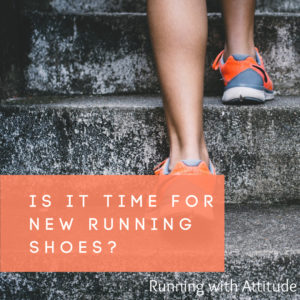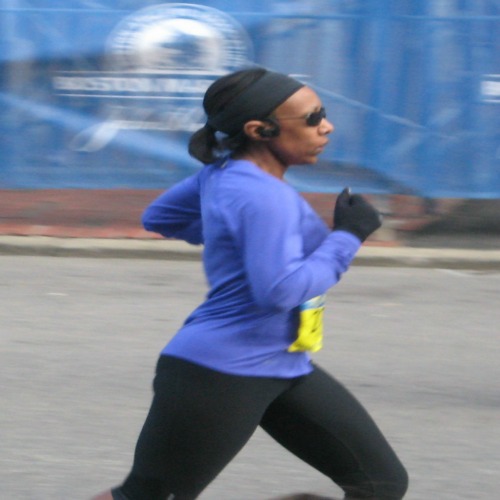Happy Friday!
Welcome to another edition of Fit Five Friday with My First 5K and More, Run Laugh Eat Pie, Runs with Pugs, Zenaida, and yours truly!
Today’s post is inspired by a recent exchange with my husband who’s been complaining lately about calf pain after each run. When I asked how long had he been running in those shoes and received a somewhat blank look in response, I reminded him that running in shoes past their prime could cause discomfort and lead to injuries.
While I’m always game for a new pair of running shoes, the general “rule” is to replace them every 300 – 400 miles. That mileage range depends on several factors including the terrain you run on, your running style, and weight. Consider these 5 signs that it might be time for new running shoes.
Fit Five Friday – Is it time for new running shoes?
Appearance Matters — This one may seem obvious but if your shoes look like they have seen better days, it may be time to retire them. Don’t just pay attention to the wear of the tread, also look at the wear and tear (literally!) on the uppers, especially at the seams and the collar of the shoes. Did you know that creasing along the outer midsole is a sign of compressed cushioning?
High Mileage — So even if you don’t track your mileage, if you pay attention to the date you purchase your shoes, you can come up with a rough estimate of how miles you’ve logged on those shoes. It’s also important to bear in mind that not all miles are created equal – the surface you run on matters. Treadmill runners can probably go to the higher end of the mileage range vs. road and trail runners.
Too Many Activities — Do you use just one pair for all activities (road running, trail running, cross-training, and walking)? There is something to be said for using your shoes for their intended activity – i.e., use your running shoes just for running. And, if you run on both roads and trails, be sure to have appropriate shoes for each surface. Your run shoes will break down faster if they never get a break because the midsole foam never gets a chance to bounce back (typically it takes a day for the foam to recover). So if you’re a run streaker, you’d be better served to have a couple of pairs of shoes in rotation.
Experiencing Pain — The age of your shoes may not be the cause of your discomfort but it’s definitely something to consider. If you’re feeling joint pain (hello knees and hips!), pain in your feet, or significant muscle fatigue, it may be time to start shopping for a new pair.
Blistering — Blisters come from ill-fitting shoes. If you are experiencing blisters when you didn’t before, it may be a sign that your shoes are losing their shape.
Is it time for new running shoes? Five things to consider. #FitFiveFriday #bibchat #runchat #runningshoes Share on XDo you track the mileage on your running shoes? How do you decide when to retire your shoes?
Welcome to Fit Five Friday!
Join My First 5K and More, Running With Attitude, Run Laugh Eat Pie, Runs with Pugs, and Zenaida every Friday for Fit Five Friday! Share your fitness-related post, link back to your hosts, and please share the link love by visiting and commenting on your hosts and at least two other Fit Five Friday bloggers!
Related Posts











I don’t track my shoes but I should. I have quite a few pairs and I rotate them. I look at the soles but more importantly it’s how I feel. My lower back aches on long runs. So I use those for shorter ones. Eventually just walking. Then I give them away.
I try to wear newish shoes for half marathons.
Thanks for the tips.
I’ve never tracked my mileage for each shoe, but I do rotate which ones I use. The newbies get prime use for long runs, and the older shoes get more use for short runs. I also have a few shoes that I use for speed work because they don’t have the optimum support for longer runs. I use my “retirees” on the bike or for walking 🙂
I don’t track my mileage either, but I’m usually aware of how old the shoes are. Right now since I’m only running every other day, i only have one pair but normally i have a couple pairs I rotate. When I’m done with them for running, I’ll throw them in the washing machine and if they don’t look too beat up, I can wear them for work! i just got new Hokas and am wearing my old ones at work- my feet are very happy.
I don’t track but I go by feel and usually use my shoes in rotation for 3 – 4 months and have to replace them. I run a lot of miles 😉
This is the perfect summary! All of these things contribute and I do my best to use my running shoes only for running and to not let them get too ol
I know I should track my mileage, but since I rotate between shoes, I rarely do. When I’m not racing in general I’ll buy new shoes twice a year. My husband of course doesn’t understand why I need new shoes if I’m not even racing. 🙂
If I’m racing, I might buy new shoes about 6 weeks before a goal race — that new shoe bounce is real!
Sometimes it’s just by feel.
Like you, I need no excuse for new running shoes! I do track my mileage and keep an eye on wear and tear. No one needs injuries from worn out shoes!
“While I’m always game for a new pair of running shoes”
LOL, my answer to your post title was “Yes” even before I read this comment. While I do track my shoes’ mileage in Strava, my knee barometer starts to remind me as I inch closer to 250. It’s useful to know. Lucky I’m not a gold person since the Ghosts are finally in a St. Pats’ edition
I know I should keep track of my miles, but because I switch shoes frequently, I rarely do. When I’m not racing, I replace my shoes every two years. My spouse, understandably, is baffled as to why I need new shoes when I’m not even racing.I might get new shoes approximately 6 weeks before a goal race if I’m racing the new shoe bounce is genuine. Sometimes it’s just a matter of instinct.
PICKTHEVOUCHER recently posted…Top 10 Best Kitchen Storage Baskets Reviews 2022
Great tips for knowing when it’s time to replace your running shoes! Key signs include visible wear on the uppers, compressed cushioning, and pain during or after runs. Don’t forget to track your mileage — typically, shoes should be replaced after 300-400 miles. Rotating shoes and using them for their intended purpose can also extend their lifespan. Pay attention to discomfort like joint pain or blisters, as these may signal it’s time for a new pair. Great advice for keeping your runs injury-free!